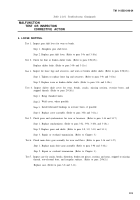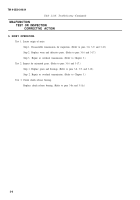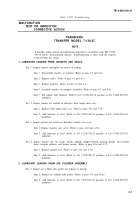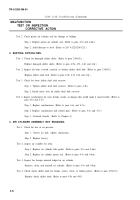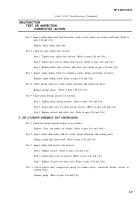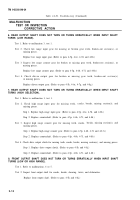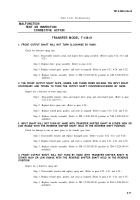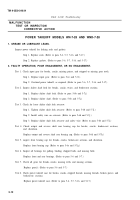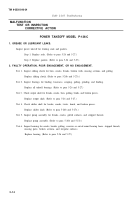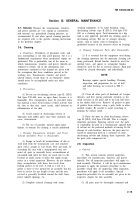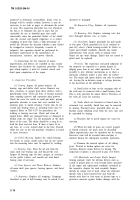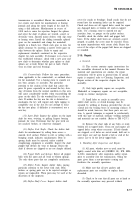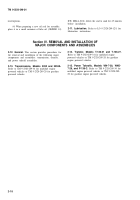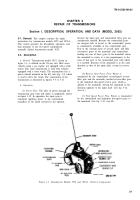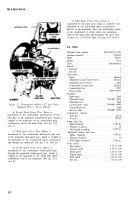TM-9-2520-246-34 - Page 32 of 153
TM 9-2520-246-34
Section III. GENERAL MAINTENANCE
2-7. General.
Because the transmissions, transfers,
and power takeoffs are very similar in construction
and material, use generalized cleaning practices, as
recommended. If and when special cleaning practices
are required, refer to the specific cleaning instructions
in the pertinent chapter.
2-8. Cleaning.
a. Cleanliness.
Cleanliness of personnel, tools, and
area surroundings is not only good practice, but it is a
fundamental requirement when mechanical repairs are
performed. This is particularly true of the areas in
which transmissions, transfers, and power takeoffs are
repaired or rebuilt. All of the information and
instructions contained in this manual are given with
the assumption that these conditions prevail in the
working area. Transmission, transfer, and power
takeoff repairs, except those of an emergency nature,
should never be accomplished under any other
conditions.
b. Precautions.
(1) Do not use drycleaning solvent, type II, (SD-2)
Fed Spec P-D-680, near an open flame because it is
flammable. Fire extinguishers must be provided when
this material is used. Avoid contact of these solvents with
the skin as they may cause cracks, mild irritation or
inflammation of the skin.
(2) Avoid contact of drycleaning solvent or
lubricants with rubber parts since these materials can
cause deterioration.
(3) The use of gasoline, mineral spirits paint
thinner, or benzine for cleaning is strictly prohibited.
c. Cleaning Transmission, Transfer, and Power
Takeoff Assemblies Prior to Disassembly.
(1) Scrape or brush all accumulations of dirt or
road mud from the transmission case and attached
parts with a scraper or wire brush. Note and mark, by
scratching the case with a sharp-pointed tool, any
moist oil spots or unusually heavy accumulations of
oil-soaked road mud, for these are good clues to the
location of small cracks or holes that might escape
notice in a visual inspection. However, do not confuse
these accumulations with those that result from
leaking gaskets or oil seals. A leak at a seal or a
gasket is more or less normal for an assembly that has
been in service for any length of time, and the area
covered is generally localized around the shaft bores,
power takeoff openings, etc.
(2) Complete external cleaning with steam-
cleaning equipment, or by hand brushing, using
drycleaning solvent, type II (SD-2), Fed Spec P-D-
680, as a cleaning agent. Total immersion in a dip
tank is also approved, provided the cleaning agent is
drycleaning solvent. The use of stronger cleaning
agents, such as caustic soda or detergents, is
prohibited because of the corrosive effect on bearings.
d. Cleaning Component Parts After Disassembly.
(1) It is essential that the equipment used during
the cleaning operation suit the particular cleaning job
being performed. Round brushes should be used for
internal bores, and square or rectangular brushes
should be used for flat or external surfaces. Each part
should be cleaned thoroughly and individually.
NOTE
Bearings require special handling. Cleaning,
inspection, and preparation for use of ball
and roller bearings are covered in TM 9-
214.
(2) Clean all other parts of hardened oil, lacquer
deposits, and dirt, paying particular attention to the
small oil holes in the gears and to the lock ball bores
in the shifter shaft cover. Remove all gaskets or parts
of gaskets from surfaces, using a putty knife or other
suitable scraper. Be careful to avoid scratching or
gouging the surface metal.
(3) Rinse the parts in clean drycleaning solvent
type II (SD-2), Fed Spec P-D-680. This is a highly
important operation. Spraying solvent over the parts
or suspending the part in a mechanically agitated bath
of solvent are the preferred methods of rinsing. In the
absence of such facilities, however, the parts may be
rinsed by immersing them in a container of clean
drycleaning solvent and shaking them vigorously. Dry
the parts with compressed air.
2-9. Inspection.
a. General.
(1) This section contains general inspection
procedures for transmissions, transfers, and power
takeoffs. Not all inspection procedures will apply to
each assembly. Therefore, it will be up to maintenance
personnel to apply the pertinent procedure to the
assembly which they are inspecting. Most inspection
procedures will apply to all assemblies. Special
inspection procedures for an assembly are given in the
respective chapter for that assembly.
(2) All parts must be thoroughly examined and
2-15
Back to Top

